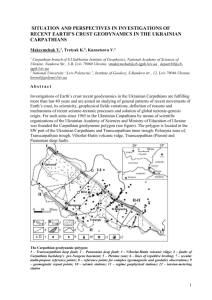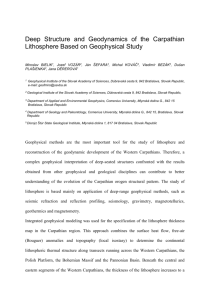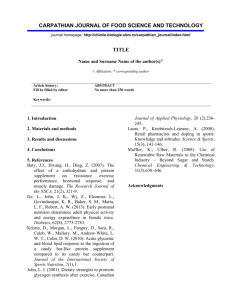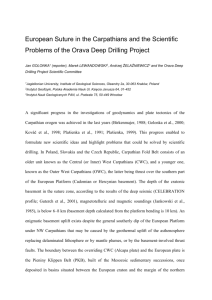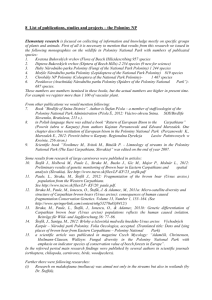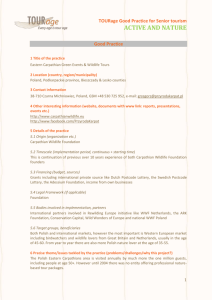The East Slovakian triple point junction area
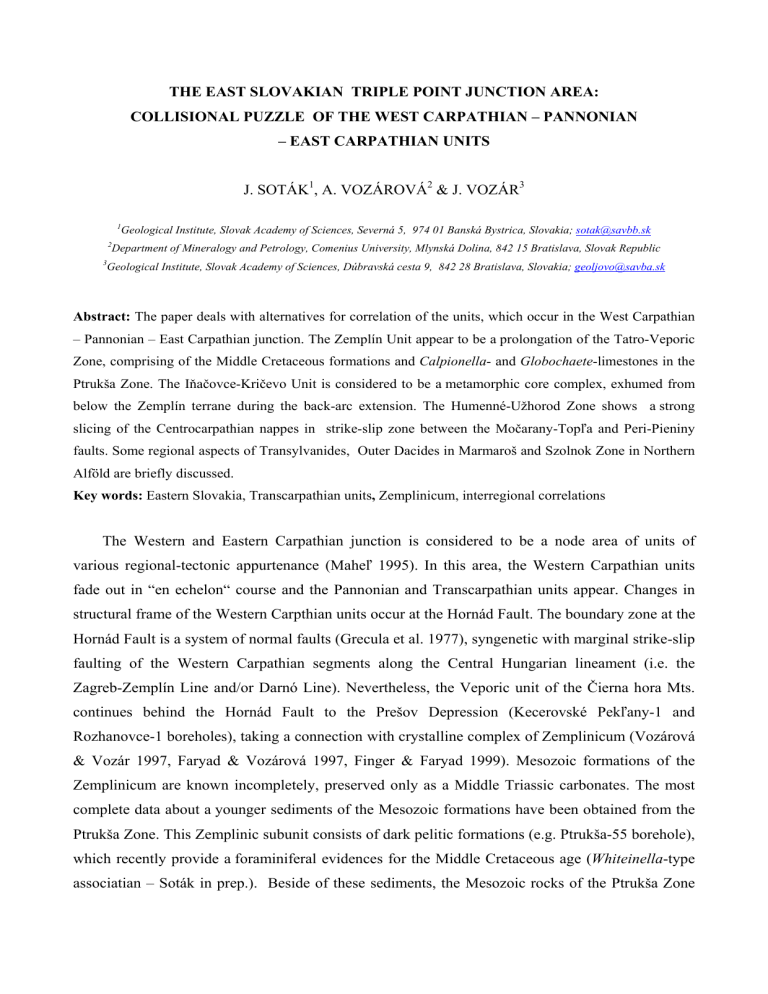
THE EAST SLOVAKIAN TRIPLE POINT JUNCTION AREA:
COLLISIONAL PUZZLE OF THE WEST CARPATHIAN – PANNONIAN
– EAST CARPATHIAN UNITS
J. SOTÁK 1 , A. VOZÁROVÁ 2 & J. VOZÁR 3
1 Geological Institute, Slovak Academy of Sciences, Severná 5, 974 01 Banská Bystrica, Slovakia; sotak@savbb.sk
2 Department of Mineralogy and Petrology, Comenius University, Mlynská Dolina, 842 15 Bratislava, Slovak Republic
3 Geological Institute, Slovak Academy of Sciences, Dúbravská cesta 9, 842 28 Bratislava, Slovakia; geoljovo@savba.sk
Abstract: The paper deals with alternatives for correlation of the units, which occur in the West Carpathian
– Pannonian – East Carpathian junction. The Zemplín Unit appear to be a prolongation of the Tatro-Veporic
Zone, comprising of the Middle Cretaceous formations and Calpionella - and Globochaete -limestones in the
Ptrukša Zone. The I ň a č ovce-Kri č evo Unit is considered to be a metamorphic core complex, exhumed from below the Zemplín terrane during the back-arc extension. The Humenné-Užhorod Zone shows a strong slicing of the Centrocarpathian nappes in strike-slip zone between the Mo č arany-Top ľ a and Peri-Pieniny faults. Some regional aspects of Transylvanides, Outer Dacides in Marmaroš and Szolnok Zone in Northern
Alföld are briefly discussed.
Key words: Eastern Slovakia, Transcarpathian units , Zemplinicum, interregional correlations
The Western and Eastern Carpathian junction is considered to be a node area of units of various regional-tectonic appurtenance (Mahe ľ 1995). In this area, the Western Carpathian units fade out in “en echelon“ course and the Pannonian and Transcarpathian units appear. Changes in structural frame of the Western Carpthian units occur at the Hornád Fault. The boundary zone at the
Hornád Fault is a system of normal faults (Grecula et al. 1977), syngenetic with marginal strike-slip faulting of the Western Carpathian segments along the Central Hungarian lineament (i.e. the
Zagreb-Zemplín Line and/or Darnó Line). Nevertheless, the Veporic unit of the Č ierna hora Mts. continues behind the Hornád Fault to the Prešov Depression (Kecerovské Pek ľ any-1 and
Rozhanovce-1 boreholes), taking a connection with crystalline complex of Zemplinicum (Vozárová
& Vozár 1997, Faryad & Vozárová 1997, Finger & Faryad 1999). Mesozoic formations of the
Zemplinicum are known incompletely, preserved only as a Middle Triassic carbonates. The most complete data about a younger sediments of the Mesozoic formations have been obtained from the
Ptrukša Zone. This Zemplinic subunit consists of dark pelitic formations (e.g. Ptrukša-55 borehole), which recently provide a foraminiferal evidences for the Middle Cretaceous age ( Whiteinella -type associatian – Soták in prep.). Beside of these sediments, the Mesozoic rocks of the Ptrukša Zone
are also reworked in the marginal delta-fan conglomerates of the Neogene formations (e.g. Ptrukša-
55 borehole), where the carbonate pebbles consist of dolomites, Calpionella -limestones and
Globochaete -limestones. Considering that, the Mesozoic formations of the Ptrukša Zone
(Zemplinicum) are not different from those in the Central Carpathian units. Nevertheless, the
Zemplín Unit is considered to be a marginal segment of the Tisia block wedged in structures of the
Western Carpathians along the Zagreb-Zemplín and Trebišov-Samoš Lines (Grecula et al. 1981).
Mesozoic units of the Central Western Carpathians beyond the Hornád Fault occur in the
Humenské vrchy Mts. as well. They form an elevated area of the Humenné – Užhorod Zone.
Structure of these units in the Humenské vrchy Mts. revealed a strong slicing of Krížna, Tatric and perhaps also Cho č nappes (Mahe ľ 1995, Jacko & Schmidt 1994, Soták et al. 1997). The Humenné
Unit joints with the basement units of the East Slovakian Basin (I ň a č ovce-Kri č evo Unit) on the strike-slip system of the Mo č arany-Top ľ a Faults, indicating their possible tectonic juxtaposition.
Eastward continuation of Mesozoic units along the inner side of the Klippen Belt is also traced by the Central Carpathian Paleogene sediments of the Kapušany-Humenné-Be ň atina Zone, and than up to Transcarpathian area. The “Podhale Flysch” in the Transcarpathian area is developed as Šaflary
Fm. and Zakopane Fm. (Sviridenko 1973), that like as in the Šambron Zone, contain extremely abundat spinels (Kruglov 1974).
The Gemericum seems to not continue beyond the Hornád Fault, where it sharply turns in N-S direction (Grecula et al. 1981). Nevertheless, there are also opinions, that the Gemeric-like complexes ocurr in the nappe structure of the Marmarosh massif. The Early Paleozoic formations of the Marmaroš massif are dated by the Ordovician graptoliths and conodonts (Drygant &
Bojchevskaja 1984). The Marmaroš massif shows a simmilarity to the Central Western Carpathians, which differ only in magnitude of horizontal displacement (Slavin et al. 1975). Another interpretations refuse this correlation, emphasizing the principal role of the Pieniny boundary fault
(Vjalov 1975, Sviridenko 1976). However, the Marmaroš elements occur in the basement of the
Transcarpathian Depression in Solotvino area as well (Petraškevi č 1968). This part of the
Transcarpathian Depression is floored by the epicontinental Paleogene sediments (Bajlovo Fm.), which correspond to variegated facies of the Paleogene sediments in the Marmaroš massif
(Petraškevi č l.c.).
At the junction of the Inner Carpathians with the Zemplín block probably disappear also units of the Silicicum - and Bükk-Meliata domain. Toward the east, the Meliata?-type sequence with radiolarites?, diabases and tuffites is constrained from boreholes near Beregovo and in Rusko-
Komarov and Bega č Zones (Sviridenko 1976, Petrashkevi č & Lozyniak 1988). Based on these
indications, Rakús et al. (1998) proposed a prolongation of Transylvanides to the basement structure of the Transcarpathian Depression.
The substratum of the Transcarpathian Depression is formed by the I ň a č ovce- Kri č evo Unit, which consists of Late Paleozoic?, Mesozoic and Paleogene formations. Their stratigraphic classification is based on the occurrences of Jurassic and Lower Cretaceous fauna in the Kri č evo
Zone (Posidonia sp., Vermicerae sp. Deshayesites borowae UHLIG, calpionellids – Burrov et al.
1975). In the basement of the East Slovakian Basin, the I ň a č ovce-Kri č evo Unit consists of metasedimentary formations. This unit is supposed to be a subduction complex (Soták et al. 1993,
1994, Vozár et al. 1993), based on the metamorphic lithology, MP to HP/LT metamorphism, Lower
Miocene cooling age ( ≈ 20 Ma) and subductional-accretionary deformation. Metasedimentary formations of the I ň a č ovce-Kri č evo Unit are also completed by bodies of ultrabasics, recovered in deep boreholes and presumed in the area of large magnetic anomalies near Nacinná Ves and
Se č ovce (Mo ř kovský & Č ver č ko 1987, Gnojek et al. 1991). In the Eastern Carpathians, the Jurassic and Cretaceous sediments with oceanic lithologies occur in the Ceahlau – Severin Zone, which westwardly links with the Porkurec Unit of the Ukraine Carpathians. The Porkurec Unit disappears in the system of Latorica faults, close to the Slovak-Ukraine border. According to some authors
(e.g. Kovács 1982, Chain et al. 1980), the oceanic-type units in the East Carpathian – Pannonian area are divided into two zones – Outer Dacide Zone (“Black Flysch” and Ceahlau Units) and
Szolnok Zone. I ň a č ovce-Kri č evo Unit seems to be in direct connection with the Szolnok Zone. This zone is formed by the Senonian and Paleogene sediments, which were detached from the Mecsektype units (Balla 1987). Pelagic marly facies of the Szolnok Zone (Púchov Marls) and the Mesozoic formations of the Mecsek Unit are not present in the I ň a č ovce-Kri č evo Unit. Considering that, the
Mesozoic formations of the Szolnok Zone likely correlate with those in the Pieniny Klippen Belt
(Szentgyörgyi 1989, Soták et al. 1995, Potfaj 1998).
The units of the Western and Eastern Carpathian junction are covered by Neogene sediments of the Eastern Slovakian Basin, which in the deepest part attain thickness of up to 6-7 km (the so called Trebišov Depression sensu Rudinec 1980). The subsidence of the basin during the Lower
Miocene was taking place in depocentres formed by pull-apart mechanism (Vass et al. 1988), which also documents its foundation in the transtensional shear zone. During the Middle Miocene, the structural development of the basin tend to back-arc extension (Ková č et al. 1995). Back-arc extension, mainly initiated by roll-back effect of the subducted plate, consequently forced the mantle upheaval and intensive calc-alkaline volcanism. Andesite eruptive centres were mainly activated at crossing of significant tectonic lines in the system of volcanic apparatuses of the
Slanské vrchy and Vihorlat – Gutin Mts. (Kali č iak and Pospíšil 1990).
The paper is a contribution to VEGA grant no. 7068.
References
Balla, Z. 1987: Anticlockwise rotation of the Mecsek (south west Hungary) in the Cretaceous: Interpretation of paleo magnetic data in the light of the geology. Ált. Földt. Szemle, 22, 55-98.
Burrov, V.S., Kruglov, S.S., Sviridenko, V.G. Šakin, A., 1975: Nekotorye novye predstavlenija o tektonike Ukrainskich
Karpat i prilegajuš č ich progibov. Proceeding of the 10 th Congress CBGA, sec. III, Tectonics, Bratislava, 75-82.
Chain, V.E., Beer, M. A., Byzova, S.L., Lomize M.G., & Rudakov, S.G., 1980 : Tectonic Development of the Eastern
Car pathians in the Light of Modern Geosynclinal Concepts. Proceedings of the XI Congress of Carpathian-Balkan
Geological Association, Tectonics, "Naukova dumka", Kiev, 214-232.
Drygant, D.M. & Bojchevskaja, L.T., 1984: Piervaja nakhodka niznieordovikshih graptolitov i konodontov v ukrainskich Karpatoch. Doklady Akad. Nauk Ukrain. SSR, B, 6, 8-11.
Faryad, S.W. & Vozárová, A., 1997: Geology and metamorphism of the Zemplinicum basement unit (Western
Carpathians). In: Grecula, P., Hovorka, D. & Putiš, M. (eds.): Geological evolution of the Western Carpathians.
Miner. slovaca – Monograph, 351-358.
Finger, F. & Faryad, S.W., 1999: A Variscan monazite age from the Zemplin basement (eastern Western Carpathians).
Acta Geol. Hungar., 42/3, 301-307.
Gnojek I., Hovorka D. & Pospíšil L., 199l: Sources of magnetic anomalies in the pre-tertiary basement of Eastern
Slovakia (Czecho-Slovakia). Geol. Carpathica, 42, 3, 169-180
Grecula P., Kali č iak M., Varga I., 1977: The Hornád fault system and its problems (Eastern Slovakia).
Miner. slovaca,
9, 6, 417-448 .
Grecula P., Kali č iak M., Tözser J. & Varga I., 1981: Geology of the borderland between the West and East Carpathians in the work of Ján Slávik: new data, correlations and problems. Regularities of raw material distribution. - In.
Grecula P. (ed.): Geological structure and raw materials in the border zone of the East and West Carpathians.
Košice,
17-31 .
Jacko S. jun. & Schmidt R., 1994: Structural and geological pattern and paleostress analysis of Mesozoic complexes between Jasenov and Oreské villages; Humenské vrchy Mts. Eas tern Slovakia. Miner. slovaca, 26, 3, 206-211 .
Kali č iak M. & Pospíšil L., 1990: Neogene magmatism in Transcarpathian depression: geological and geophysical evaluation. Miner. slovaca, 22, 6, 481-498 .
Kovács, S., 1982: Problems of the "Pannonian Median Massif" and the plate tectonic concept: Contributions based on the distribution of late Paleozoic-early Mesozoic isopic zones. Geol. Rundsch., 71. 617-640.
Ková č M., Ková č P., Marko F., Karoli S. & Jano č ko J. 1995: The East Slovakian Basin - A complex back-arc basin.
Tectonophysics, 252, pp. 453-466 .
Kruglov, S.S., 1974: The Pieniny Klippen Zone. In: Mahe ľ , M. (ed.): Tectonics of the Carpathian – Balkan regions.
GUDŠ Bratislava, 205-209.
Mahe ľ M., 1995: Fan-like synclinorias and klippen style: the manifestations of mezoalpine tectogenesis. In: M. Kali č iak
(ed.): III. Geologické dni J. Slávika, Konferencie - Sympózia - Semináre , GÚDŠ Bratislava, 33-38 .
Mo ř kovský M. & Č ver č ko J., 1987: Magnetic anomalies in the Neogene basement of the East Slovakian Lowland.
Miner. slovaca, 19, 3, 255-260 .
Petraškevi č , M. I., 1968: Geologi č skoje storjenie i neftegazonosnos ť Zakarpatskogo vnutrennego progiba. Tr. Ukr.
NIGRI, vyp. 21, “Nedra”, Moskva, 190 pp.
Petraškevi č , M. & Lozyniak, P., 1988: Strukturnoje rajonirovanie Zakarpatskogo prehybu. Reg. Geol. Ukr. Sov. Rep.
Sbor. ved. prác, Ľ vov, 72-79.
Potfaj, M. 1998: Geodynamics of the Klippen Belt and Flysch belt in the Western Carpathians. In: Geodynamic development of the Western Carpathians (Ed. M. Rakus), D. Štúr Publishers, Bratislava, 143-154
Rakús, M., Potfaj, M. & Vozárová, A., 1998: Basic paleogeographic and paleotectonic units of the Western
Carpathians. In: Geodynamic development of the Western Carpathians (Ed. M. Rakús ), D. Štúr Publishers,
Bratislava, 143-154.
Rudinec R., 1980: Possibilities of oil and gas occurrences in the pre-Neogene basement of the East Slovakian basin.
Miner. slovaca, 12, 6, 507-531 .
Szentgyörgyi, K. 1989: Sedimentological and faciological characteristics of the Senonian pelagic formations of the Hun garian Plain. Acta Geol. Hung., 32, 1-2, 107-116.
Slavin, V.I., Chain, V.E. & Rudakov, S.G., 1975: O položenii zony Marmarošskych utesov i Marmarošskogo massiva v pokrovno-sklad č atom sooruženii Karpat. Proceeding of the 10
291-297. th Congress CBGA, sec. III, Tectonics, Bratislava,
Soták J., Rudinec R. & Spišiak J., 1993: The Penninic "pull- apart" dome in the pre-Neogene basement of the
Transcarpathian Depression (Eastern Slovakia). Geol. Carpathica, 44, 1, 11-16 .
Soták J., Spišiak J. & Biro ň A., 1994: Metamorphic sequences with "Bündnerschiefer" lithology in the pre-Neogene basement of the East Slovakian Basin.
Mitt. Österr. Geol. Ges., Wien, 111-120.
Soták, J., Biro ň , A., Kotulová, J., Rudinec, R. & Spišiak, J., 1995: Geological structure of the East Slovakian basin basement in the light of facts and regional tectonic context . Miner. slovaca, 27, 1, 1-8.
Soták J., Michalík J., Reháková D., Hamršmíd B., 1997: Paleogene sediments below the base of a Mesozoic nappe in the Humenské vrchy Mts. (Podskalka borehole): stratigraphic constraints for Tertiary thrust tectonics. Geol.
Carpathica, 48, 3, 1997, 193-203.
Sviridenko, V.G. 1975: Paleogene deposits in the basement of the Transcarpathian Trough and their correlation with deposits of the neighbouring regions. Proceedings of the 10 th Congress CBGA, sec. III Tectonics, Bratislava, 298-
304.
Sviridenko, V. G. 1976: Geological structure of the Pre-Neogene substratum of the Transcarpathian Depression.
Miner. slovaca, 8, 5, 395-406.
Vjalov, O.S., 1975: Uspechi izu č enija tektoniki Karpat . Proceedings of the 10 th Congress CBGA, sec. III Tectonics,
Bratislava, 314-325.
Vozár, J., Tomek, Č . & Vozárová, A., 1993: Reinterpretácia predneogénneho podložia východoslovenskej panvy.
Miner. slovaca, 25, 6, Geovestník, 1-2.
Vozárová, A. & Vozár, J., 1997: Terranes of the West Carpathian-North Pannonian domain. Annales Géol.
Helléniques, T. XXXVII., 245-269.
Vass D., Ková č M., Kone č ný V. & Lexa J., 1988: Molasse basins and volcanic activity in West Carpathian Neogene - its evolution and geodynamic character. Geol. Zbor. Geol. Carpathica (Bratislava), 39, 5, 539-561.
Fig. 1 Tectonic sketch of the basement units in the West Carpathian – Pannonian – East Carpathian junction.
